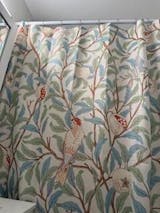In the heart of the English countryside, nestled between rolling hills and ivy-clad trees, there stood a humble cottage, a dwelling of such grace and charm that it seemed to belong more to the pages of an old fairy tale than the modern world. The cottage was built of warm honey-coloured stone, its thatched roof soft as a cloud against the sky, and its windows framed with delicate climbing roses. The garden was a patchwork quilt of wildflowers - poppies, daisies, lavender, foxgloves and daffodils - each one blooming with the quiet assurance of nature’s eternal rhythm.
Inside the cottage, the air smelled of wood and freshly brewed tea. The rooms were modest but filled with character, each corner a testament to a time long past, when life was simpler, and beauty was created from the hands of artisans who understood that everything around them, from the simplest chair to the grandest tapestry, was a piece of art in its own right.
The cottage was the home of a quiet, thoughtful woman with a deep love for the natural world. She spent most of her day working from home, later afternoons in the garden with her dogs and in the evenings, she would sit by the hearth, knitting, reading or simply gazing out of the window at the changing landscape. But what set her apart was her love for the works of a man who had long since passed from the world, though his influence still lingered in every stitch of fabric, every brushstroke of paint and every piece of furniture that graced her home.
That man was William Morris.
William Morris, the poet, artist and social activist, had once said, "Have nothing in your houses that you do not know to be useful or believe to be beautiful." The woman, more than anyone, understood this sentiment. She had surrounded herself with things that held meaning, objects that whispered stories of a time when craft and beauty were intertwined with daily life.
In her living room, a large tapestry hung on the wall opposite the window bathed in morning light - a masterpiece of Morris’s design, woven with intricate floral patterns that seemed to breathe life into the room. The fabric, rich in orange and golden yellows, depicted a botanical pattern and intertwining vines. The tapestry was more than just decoration; it was a reminder that nature with all its chaos and order, was the truest form of art.
Her furniture, too, bore the marks of Morris’s legacy. The vintage wooden chairs, dark and polished with age, had been hand-carved with delicate vines and leaves, echoing the natural motifs that Morris had so loved. The long dining table, laid with a Table Cloth, Cloth Napkins and Placemats from Willy Morris Home Emporium, held a vase of freshly picked flowers from the garden - bright daffodils, their scent filling the room as if to remind her of the beauty outside her door.
She had come to appreciate Morris’s ideas not just for their aesthetic, but for their philosophy - his belief in the interconnectedness of beauty, craftsmanship and a life well-lived. In a world where mass production was beginning to take hold, Morris had longed for a return to the hand-made, the uniquely crafted and the deeply personal. He believed that beauty, when created with care and intention, could elevate the soul.
One evening, as the sun began to set and the first stars of the evening sky twinkled faintly above, she sat by the fire, a cup of tea cradled in her hands. She looked around the room and thought of Morris, of his many designs and of the way his patterns had influenced her home decor. She had always felt a connection to him, as if his spirit lived on in the very fibres of her home, in the patterns of the flowers that bloomed in her garden and in the delicate threads of the tapestries she treasured.
It was on this quiet evening she thought "I think it's time for a dinner party". An evening for her friends like-minded souls like her who shared her love for the simple beauty of the world. And so the next Saturday, in the soft glow of candlelight, the guests arrived, drawn by the warmth of the fire and the soft glow of the table lamps. They admired the tapestries, the furniture and the home decor pieces from Willy Morris Home Emporium.
As the night deepened, she stood by the window, watching the moon rise over the hills. The world outside was quiet but within her cottage the warm glow of candlelight flickered off the stone walls as friends laughed loudly, clinked glasses, played cards and savoured homemade dishes at a cozy dinner party inside the charming, old cottage surrounded by beauty, creativity and conversation.
And so, the story of the cottage, a home, a woman's sanctuary and of William Morris & Co patterns lived on, woven into the fabric of time, where beauty and art would forever find a home in the hearts of those who cared to look. She knew that in her small way, she was continuing the legacy of William Morris - that she, too, was living a life where beauty, both in the simplest of things and the grandest of designs, was always present, always worth cherishing.


